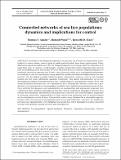Files in this item
Connected networks of sea lice populations : dynamics and implications for control
Item metadata
| dc.contributor.author | Adams, Thomas P. | |
| dc.contributor.author | Proud, Roland | |
| dc.contributor.author | Black, Kenneth D. | |
| dc.date.accessioned | 2015-08-07T11:10:04Z | |
| dc.date.available | 2015-08-07T11:10:04Z | |
| dc.date.issued | 2015-05 | |
| dc.identifier | 207998466 | |
| dc.identifier | aef418ed-4d7a-4c35-94c7-c63c63a68690 | |
| dc.identifier | 000355884400006 | |
| dc.identifier | 84929868825 | |
| dc.identifier | 000355884400006 | |
| dc.identifier.citation | Adams , T P , Proud , R & Black , K D 2015 , ' Connected networks of sea lice populations : dynamics and implications for control ' , Aquaculture Environment Interactions , vol. 6 , no. 3 , pp. 273-284 . https://doi.org/10.3354/aei00133 | en |
| dc.identifier.issn | 1869-215X | |
| dc.identifier.other | ORCID: /0000-0002-8647-5562/work/35710931 | |
| dc.identifier.uri | https://hdl.handle.net/10023/7148 | |
| dc.description | This work was supported by a grant from the European Fisheries Fund (European Union). Date of Acceptance: 14/04/2015 | en |
| dc.description.abstract | In studies of the population dynamics of parasitic sea lice and the implications of outbreaks for salmon farms, several types of mathematical models have been implemented. Delay differential equation models describe the temporal dynamics of average adult lice densities over many farm sites. In contrast, larval transport models consider the relative densities of lice at farm sites by modelling larval movements between them but do not account for temporal dynamics or feedbacks created by reproduction. Finally, several recent studies have investigated spatiotemporal variation in site lice abundances using statistical models and distance-based proxies for connectivity. We developed a model which integrates connectivity estimates from larval transport models into the delay differential equation framework. This allows representation of sea lice developmental stages, dispersal between sites, and the impact of management actions. Even with identical external infection rates, lice abundances differ dramatically between farms over a production cycle (dependent on oceanographic conditions and resulting between-farm connectivity). Once infected, lice dynamics are dominated by site reproduction and subsequent dispersal. Lice control decreases actual lice abundances and also reduces variation in abundance between sites (within each simulation) and between simulation runs. Control at sites with the highest magnitude of incoming connections, computed directly from connectivity modelling, had the greatest impact on lice abundances across all sites. Connectivity metrics may therefore be a reasonable approximation of the effectiveness of management practices at particular sites. However, the model also provides new opportunities for investigation and prediction of lice abundances in interconnected systems with spatially varying infection and management. | |
| dc.format.extent | 12 | |
| dc.format.extent | 641622 | |
| dc.language.iso | eng | |
| dc.relation.ispartof | Aquaculture Environment Interactions | en |
| dc.subject | Metapopulation | en |
| dc.subject | Spatial dynamics | en |
| dc.subject | Dispersal | en |
| dc.subject | Population connectivity | en |
| dc.subject | Sea lice management | en |
| dc.subject | Salmon salmo-salar | en |
| dc.subject | Farmed Atlantic salmon | en |
| dc.subject | Louse lepeophtheirus-salmonis | en |
| dc.subject | Mathematical-model | en |
| dc.subject | Scotland | en |
| dc.subject | Hardangerfjord | en |
| dc.subject | Dispersion | en |
| dc.subject | Infection | en |
| dc.subject | Growth | en |
| dc.subject | Trout | en |
| dc.subject | QH301 Biology | en |
| dc.subject | QL Zoology | en |
| dc.subject.lcc | QH301 | en |
| dc.subject.lcc | QL | en |
| dc.title | Connected networks of sea lice populations : dynamics and implications for control | en |
| dc.type | Journal article | en |
| dc.contributor.institution | University of St Andrews. School of Biology | en |
| dc.contributor.institution | University of St Andrews. Pelagic Ecology Research Group | en |
| dc.contributor.institution | University of St Andrews. Scottish Oceans Institute | en |
| dc.identifier.doi | https://doi.org/10.3354/aei00133 | |
| dc.description.status | Peer reviewed | en |
This item appears in the following Collection(s)
Items in the St Andrews Research Repository are protected by copyright, with all rights reserved, unless otherwise indicated.

